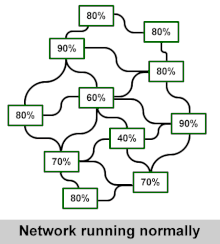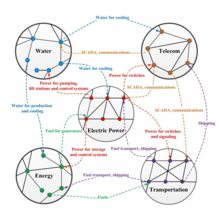
Electric power transmission is the bulk movement of electrical energy from a generating site, such as a power plant, to an electrical substation. The interconnected lines that facilitate this movement form a transmission network. This is distinct from the local wiring between high-voltage substations and customers, which is typically referred to as electric power distribution. The combined transmission and distribution network is part of electricity delivery, known as the electrical grid.

Network topology is the arrangement of the elements of a communication network. Network topology can be used to define or describe the arrangement of various types of telecommunication networks, including command and control radio networks, industrial fieldbusses and computer networks.

In computing, load balancing is the process of distributing a set of tasks over a set of resources, with the aim of making their overall processing more efficient. Load balancing can optimize the response time and avoid unevenly overloading some compute nodes while other compute nodes are left idle.

A power outage is the loss of the electrical power network supply to an end user.

The northeast blackout of 1965 was a significant disruption in the supply of electricity on Tuesday, November 9, 1965, affecting parts of Ontario in Canada and Connecticut, Delaware, Maryland, Massachusetts, New Hampshire, New Jersey, New York, Pennsylvania, Rhode Island, and Vermont in the United States. Over 30 million people and 80,000 square miles (207,000 km2) were left without electricity for up to 13 hours.
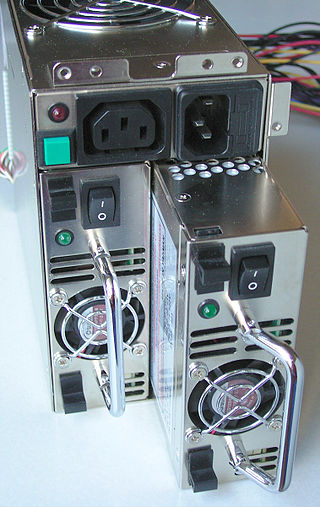
In engineering and systems theory, redundancy is the intentional duplication of critical components or functions of a system with the goal of increasing reliability of the system, usually in the form of a backup or fail-safe, or to improve actual system performance, such as in the case of GNSS receivers, or multi-threaded computer processing.
The 2003 Italy blackout was a serious power outage that affected all of the Italian Peninsula for 12 hours and part of Switzerland near Geneva for 3 hours on 28 September 2003. It was the largest blackout in the series of blackouts in 2003, involving about 56 million people.

A diesel generator (DG) (also known as a diesel genset) is the combination of a diesel engine with an electric generator (often an alternator) to generate electrical energy. This is a specific case of engine generator. A diesel compression-ignition engine is usually designed to run on diesel fuel, but some types are adapted for other liquid fuels or natural gas (CNG).
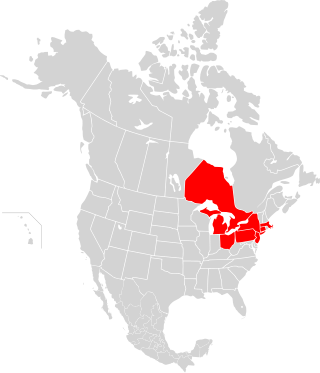
The Northeast blackout of 2003 was a widespread power outage throughout parts of the Northeastern and Midwestern United States, and most parts of the Canadian province of Ontario on Thursday, August 14, 2003, beginning just after 4:10 p.m. EDT.
Failing badly and failing well are concepts in systems security and network security describing how a system reacts to failure. The terms have been popularized by Bruce Schneier, a cryptographer and security consultant.
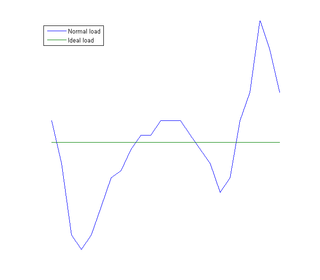
Load management, also known as demand-side management (DSM), is the process of balancing the supply of electricity on the network with the electrical load by adjusting or controlling the load rather than the power station output. This can be achieved by direct intervention of the utility in real time, by the use of frequency sensitive relays triggering the circuit breakers, by time clocks, or by using special tariffs to influence consumer behavior. Load management allows utilities to reduce demand for electricity during peak usage times, which can, in turn, reduce costs by eliminating the need for peaking power plants. In addition, some peaking power plants can take more than an hour to bring on-line which makes load management even more critical should a plant go off-line unexpectedly for example. Load management can also help reduce harmful emissions, since peaking plants or backup generators are often dirtier and less efficient than base load power plants. New load-management technologies are constantly under development — both by private industry and public entities.

Adilson E. Motter is the Charles E. and Emma H. Morrison Professor of Physics at Northwestern University, where he has helped develop the concept of synthetic rescue in network biology as well as methods to control the nonlinear dynamics of complex networks. In joint work with Takashi Nishikawa, he discovered the phenomenon of converse symmetry breaking. Motter's research is focused on complex systems and nonlinear phenomena, primarily involving complex networks, systems biology, chaos and statistical physics.

An electrical grid is an interconnected network for electricity delivery from producers to consumers. Electrical grids consist of power stations, electrical substations to step voltage up or down, electric power transmission to carry power long distances, and lastly electric power distribution to individual customers, where voltage is stepped down again to the required service voltage(s). Electrical grids vary in size and can cover whole countries or continents. From small to large there are microgrids, wide area synchronous grids, and super grids.

A single point of failure (SPOF) is a part of a system that, if it fails, will stop the entire system from working. SPOFs are undesirable in any system with a goal of high availability or reliability, be it a business practice, software application, or other industrial system.
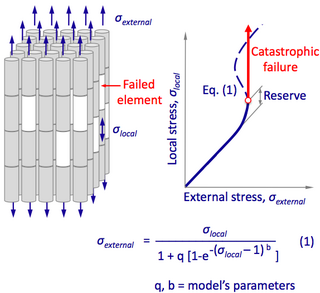
Structural fracture mechanics is the field of structural engineering concerned with the study of load-carrying structures that includes one or several failed or damaged components. It uses methods of analytical solid mechanics, structural engineering, safety engineering, probability theory, and catastrophe theory to calculate the load and stress in the structural components and analyze the safety of a damaged structure.

The 2011 Southwest blackout, also known as the Great Blackout of 2011, was a widespread power outage that affected the San Diego–Tijuana area, southern Orange County, Imperial Valley, Mexicali Valley, Coachella Valley, and parts of Arizona. It occurred on Thursday, September 8, 2011, beginning at about 3:38pm PDT, and was the largest power failure in California history.

Two severe power outages affected most of northern and eastern India on 30 and 31 July 2012. The 30 July 2012 blackout affected over 400 million people and was briefly the largest power outage in history by number of people affected, beating the January 2001 blackout in Northern India. The blackout on 31 July is the largest power outage in history. The outage affected more than 620 million people, about 9% of the world population, or half of India's population, spread across 22 states in Northern, Eastern, and Northeast India. An estimated 32 gigawatts of generating capacity was taken offline. Of the affected population, 320 million initially had power, while the rest lacked direct access. Electric service was restored in the affected locations between 31 July and 1 August 2012.

The study of interdependent networks is a subfield of network science dealing with phenomena caused by the interactions between complex networks. Though there may be a wide variety of interactions between networks, dependency focuses on the scenario in which the nodes in one network require support from nodes in another network.
In applied physics, the concept of controlling self-organized criticality refers to the control of processes by which a self-organized system dissipates energy. The objective of the control is to reduce the probability of occurrence of and size of energy dissipation bursts, often called avalanches, of self-organized systems. Dissipation of energy in a self-organized critical system into a lower energy state can be costly for society, since it depends on avalanches of all sizes usually following a kind of power law distribution and large avalanches can be damaging and disruptive.
Robustness, the ability to withstand failures and perturbations, is a critical attribute of many complex systems including complex networks.
